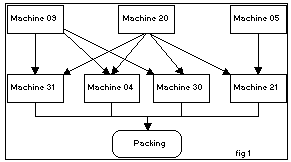
The plant in question has already been analyzed with reference to a study on how to improve the quality of the final product, considering a subsequent optimization of the production organization and creation of a package designed for actual installation in the facilities to obtain such a result. In the specific case, it was decided to perform an in-depth analysis of the plant from a production point of view to evaluate the practical operations designed to match the production capacities to the reality of the current market with limited investments.
In particular, based on the hypothetical financial operating possibilities, it was decided to evaluate the possibility of replacing several obsolete machines or to strengthen some of their components (automate retooling, reduce setting times, etc.). For what concerns the possibility of replacing the machines, an extrapolation was made to properly evaluate the real production capacities that similar components can reach in the particular operating environment (poor lighting for production of photographic films). Another important problem encountered was that relative to the redistribution of personnel inside the plant and the possible requalification of some staff members to reduce stoppages on some types of machines which, at the present time, can be operated only by a limited number of skilled technicians. The last possibility considered involves the internal transportation system, which is currently based on manual carts. Presently, these handling machines are in poor condition and since it is expected that they will be replaced, it is important to evaluate the influence that this component will have on productivity and on production efficiency to decide what might be the most justifiable type of specific investment (new ergonomic carts, electric carts, semi- automatic systems, etc.). Therefore, we can summarize those variables below which, in their entirety, are the most important ones for the analysis in question - an analysis that is designed to determine a possible plant production reorganizational configuration:
Improvements in setting time for each critical machine
Improvements in retooling time for each critical machine
Replacement of critical machines
Redistribution of personnel
Requalification of personnel
Potentials of the internal transportation system
To evaluate model performances, controlled variables were considered which, at the present time, have the most importance for the plant handlers.
Therefore, the industrial objectives analyzed included:
Packing global productivity
Productivity of the first group of machines designed for medium-small lots
Productivity of the second group of machines designed for special lots
Productivity of the most obsolete machine for large lots
Average plant crossing time for a standard product
To perform this analysis, an initial statistical evaluation was carried out on the objective functions. This evaluation indicated that the error committed on these objectives converges after about 6 months of simulation.At this point, a practical problem arose relative to running time: working on personal computers, even though they are the most advanced versions and are equipped with extended RAM, the real time needed for the experiment increased exponentially with an increase in required simulation time.
Therefore, the overall run time became high, about one hour and a half, with respect to what was initially predicted; undoubtedly the weight of the graphic interface was very large, but it is above all the management of a large number of objects in memory which was not optimized by the compiler.
This problem occurs rather frequently when building simulation models since, due to their implicit flexibility, they are normally designed for continuous improvements and upgrades which often reduce running time. Solving this problem without utilizing a simplistic transfer of the experimental phase to workstations is a real research problem since it means being able to complete an analysis phase on a complex industrial situation operating on low- cost, widely-distributed systems which are easily available in the industrial situation at an operational management level.